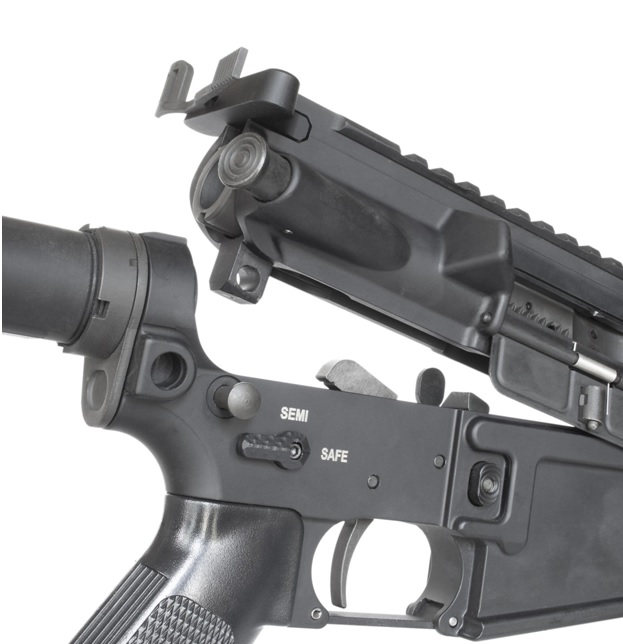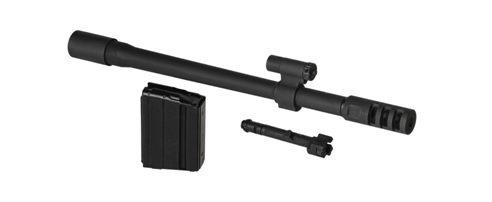Know the Difference Between Direct Impingement and Gas Piston Systems Before Building from an AR15 Kit
Jan 29th 2024
One hallmark of the AR-15 is this: the action is cycled through the mechanics of a gas system - of some sort or other.
But not all AR-15 rifles utilize the same form of gas system, let alone components. As you might know, there are adjustable gas blocks and different types of gas tubes that can be installed, as well as different bolt carrier groups - each of which is liable to have its own type of gas rings.
Beyond that, not all AR-15 rifles have the same sort of action itself. Conventionally, AR style rifles had a specific type of gas system called a direct impingement system, but another style, known as a gas piston, is gaining ground, despite the fact that it is not new.
Here’s what you need to know about the basic differences between each before you start building a sporting rifle from an AR15 kit.
How a Direct Gas Impingement System Works
If you’re familiar with the AR-15, you’re likely familiar with the direct impingement system, which is the gas system used in most AR-15 rifles.
Though the AR-15 was not the first firearm to utilize this type of gas system, it is by far the most successful one that has done so. This makes the AR sort of like a flagship for this type of gas system.
In a direct impingement system, when you pull the trigger, igniting the primer and propellant, some of that expanding gas is utilized to accelerate the bullet out of the barrel. Once the bullet passes a certain point (the gas block journal where the port is) some of the gas passes into the gas block.
This gas expands through the gas tube, which carries it back towards the gas key on the bolt carrier group. As the pressure builds, the bolt carrier group is forced back against the buffer weight and spring, into the buffer tube, at which point the spring resets it and the cycle can start over again.
Though it sounds complex, it is fairly simple, and the majority of AR-style rifles are built with this sort of gas system. Still, the gas piston system is growing in popularity. Here’s how it works and what it offers.

How a Gas Piston System Works
The gas piston system is an alternative to the direct gas impingement system that operates in the manner described above.
In a gas piston system, the gas expanding behind the bullet is still used to cycle the bolt carrier group, albeit indirectly.
Instead of the gas traveling backwards through the gas tube and directly communicating with the gas key of the BCG, in a gas piston gun, the gas in the tube pushes against a gas piston, which is itself connected to the bolt carrier group, and which cycles it back. All other aspects of cycling remain the same.
There are two broad classes of gas piston systems, which are long-stroke and short stroke.
In a short-stroke gas piston gun, the gas expands through the barrel, into the gas tube, and against the piston. To the piston is attached a connecting rod (also connected to the BCG) which cycles it.
In a long-stroke gas piston system, the gas travels through the barrel, into the gas tube, and pushes back on a gas piston that is directly connected to the BCG. in a long-strong system, there is no connecting rod; just one big piston. This makes long-stroke systems less complex than short-stroke systems, and also most robust.
With all of this being said, it’s not so black and white determining which is “better” but we will peel back the layers.
Which Is Better?
It is important to note that it cannot be blankly said that either direct gas impingement or a gas piston system is better than the other. Rather, each has advantages and disadvantages.
In the case of direct impingement, there is less reciprocating mass in the form of the gas piston (since there is none). As a result, most shooters remark that DI firearms produce less recoil.
Because there is no metal component connecting the barrel to the bolt carrier group (no piston or connecting rod) DI firearms can have their barrels free-floated. This means they are inherently more accurate than piston guns.
But this doesn’t mean that DI AR rifles are better than piston guns across the board. The piston system has some advantages, too.
For one, the gas piston system is way cleaner than the DI system. With a DI system, you’re blasting gas and fouling directly back into your bolt carrier group, and past that, into the open action. A direct impingement system will coat an action with carbon fouling, fast. This can impact cycling and feeding if the firearm is not kept fastidiously clean.
For what it’s worth, the DI system also runs hotter than a gas piston system.
With respect to the different types of gas pistons, there are some nuances between them. For one, long-stroke gas pistons have a large, heavy piston and a lot of reciprocating mass. Of the three types of gas systems mentioned here, long-stroke gas piston systems produce the most felt recoil.
The short-stroke gas piston produces less recoil than long-stroke systems, making it easier to shoot, and potentially more accurately. But, there is one drawback - because there are more parts, short-stroke gas piston systems have shorter operational lifespans than long-stroke systems.
So, ultimately, it is not about which one is better than the other, but which one makes the most sense for (or appeal to) you.

Getting Started with an AR15 Kit
If you’re thinking about building a rifle from an AR15 kit, you’re probably going to be building one with a direct impingement gas system, since those are the ones most frequently available. That’s not to say you can’t get a gas piston version if you look for it, though.
Gas impingement works for probably 99% of AR shooters, but if you still have questions our experts are here to help. Get in touch with us today at 610-250-3960 if you need more information and we would be happy to set the record straight or help you find the parts you’re looking for.

